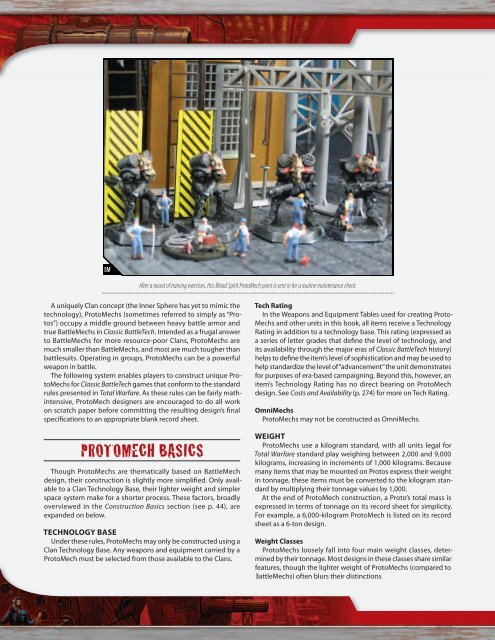the shape of things to come
the shape of things to come
the shape of things to come
Create successful ePaper yourself
Turn your PDF publications into a flip-book with our unique Google optimized e-Paper software.
SM SL<br />
After a round <strong>of</strong> training exercises, this Blood Spirit Pro<strong>to</strong>Mech point is sent in for a routine maintenance check.<br />
A uniquely Clan concept (<strong>the</strong> Inner Sphere has yet <strong>to</strong> mimic <strong>the</strong><br />
technology), Pro<strong>to</strong>Mechs (sometimes referred <strong>to</strong> simply as “Pro<strong>to</strong>s”)<br />
occupy a middle ground between heavy battle armor and<br />
true BattleMechs in Classic BattleTech. Intended as a frugal answer<br />
<strong>to</strong> BattleMechs for more resource-poor Clans, Pro<strong>to</strong>Mechs are<br />
much smaller than BattleMechs, and most are much <strong>to</strong>ugher than<br />
battlesuits. Operating in groups, Pro<strong>to</strong>Mechs can be a powerful<br />
weapon in battle.<br />
The following system enables players <strong>to</strong> construct unique Pro<strong>to</strong>Mechs<br />
for Classic BattleTech games that conform <strong>to</strong> <strong>the</strong> standard<br />
rules presented in Total Warfare. As <strong>the</strong>se rules can be fairly mathintensive,<br />
Pro<strong>to</strong>Mech designers are encouraged <strong>to</strong> do all work<br />
on scratch paper before committing <strong>the</strong> resulting design’s fi nal<br />
specifi cations <strong>to</strong> an appropriate blank record sheet.<br />
PROTOMECH BASICS<br />
Though Pro<strong>to</strong>Mechs are <strong>the</strong>matically based on BattleMech<br />
design, <strong>the</strong>ir construction is slightly more simplifi ed. Only available<br />
<strong>to</strong> a Clan Technology Base, <strong>the</strong>ir lighter weight and simpler<br />
space system make for a shorter process. These fac<strong>to</strong>rs, broadly<br />
overviewed in <strong>the</strong> Construction Basics section (see p. 44), are<br />
expanded on below.<br />
TECHNOLOGY BASE<br />
Under <strong>the</strong>se rules, Pro<strong>to</strong>Mechs may only be constructed using a<br />
Clan Technology Base. Any weapons and equipment carried by a<br />
Pro<strong>to</strong>Mech must be selected from those available <strong>to</strong> <strong>the</strong> Clans.<br />
Tech Rating<br />
In <strong>the</strong> Weapons and Equipment Tables used for creating Pro<strong>to</strong>-<br />
Mechs and o<strong>the</strong>r units in this book, all items receive a Technology<br />
Rating in addition <strong>to</strong> a technology base. This rating (expressed as<br />
a series <strong>of</strong> letter grades that defi ne <strong>the</strong> level <strong>of</strong> technology, and<br />
its availability through <strong>the</strong> major eras <strong>of</strong> Classic BattleTech his<strong>to</strong>ry)<br />
helps <strong>to</strong> defi ne <strong>the</strong> item’s level <strong>of</strong> sophistication and may be used <strong>to</strong><br />
help standardize <strong>the</strong> level <strong>of</strong> “advancement” <strong>the</strong> unit demonstrates<br />
for purposes <strong>of</strong> era-based campaigning. Beyond this, however, an<br />
item’s Technology Rating has no direct bearing on Pro<strong>to</strong>Mech<br />
design. See Costs and Availability (p. 274) for more on Tech Rating.<br />
OmniMechs<br />
Pro<strong>to</strong>Mechs may not be constructed as OmniMechs.<br />
WEIGHT<br />
Pro<strong>to</strong>Mechs use a kilogram standard, with all units legal for<br />
Total Warfare standard play weighing between 2,000 and 9,000<br />
kilograms, increasing in increments <strong>of</strong> 1,000 kilograms. Because<br />
many items that may be mounted on Pro<strong>to</strong>s express <strong>the</strong>ir weight<br />
in <strong>to</strong>nnage, <strong>the</strong>se items must be converted <strong>to</strong> <strong>the</strong> kilogram standard<br />
by multiplying <strong>the</strong>ir <strong>to</strong>nnage values by 1,000.<br />
At <strong>the</strong> end <strong>of</strong> Pro<strong>to</strong>Mech construction, a Pro<strong>to</strong>’s <strong>to</strong>tal mass is<br />
expressed in terms <strong>of</strong> <strong>to</strong>nnage on its record sheet for simplicity.<br />
For example, a 6,000-kilogram Pro<strong>to</strong>Mech is listed on its record<br />
sheet as a 6-<strong>to</strong>n design.<br />
Weight Classes<br />
Pro<strong>to</strong>Mechs loosely fall in<strong>to</strong> four main weight classes, determined<br />
by <strong>the</strong>ir <strong>to</strong>nnage. Most designs in <strong>the</strong>se classes share similar<br />
features, though <strong>the</strong> lighter weight <strong>of</strong> Pro<strong>to</strong>Mechs (compared <strong>to</strong><br />
BattleMechs) <strong>of</strong>ten blurs <strong>the</strong>ir distinctions.


